Downtown Fly Fisher, Vancouver
By D.C. Reid
George Vancouver landed at Nootka Sound with Captain James Cook
in 1774 and helped lay claim to the rocky surf-ploughed island for England.
Little did he know that his name would be appropriated not only by the island,
but also by a city which was to grow just across the strait on the
mainland - a city which is now the third largest in Canada.
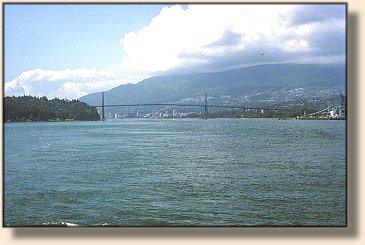
After an initial period of rivalry with Victoria, the principal city on the island
and the provincial capital, Vancouver gained the ascendancy after Ottawa
reneged on the promise to end the railroad in Victoria (discovering it was
on an island) and rightly stopped it at water's edge in Vancouver. The fur
seal industry then collapsed in Victoria. In 1915, the Panama Canal opened,
making Vancouver the port of choice for shipping Canadian grain and lumber
to the eastern United States.
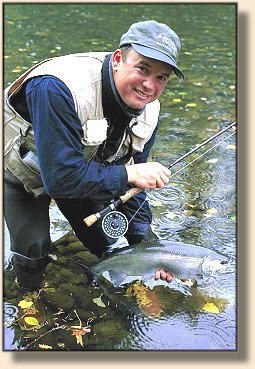 Today, metro Vancouver has a population of over 2,000,000, stretching out
along the fertile Fraser River lowlands the better part of 40 miles and just short
of Hope at the western edge of the Rocky Mountains. Twenty percent of the
population is of Asian origin and the focus of the city is on the Pacific Rim
and high tech wizardry - such as the Ballard fuel cell.
Today, metro Vancouver has a population of over 2,000,000, stretching out
along the fertile Fraser River lowlands the better part of 40 miles and just short
of Hope at the western edge of the Rocky Mountains. Twenty percent of the
population is of Asian origin and the focus of the city is on the Pacific Rim
and high tech wizardry - such as the Ballard fuel cell.
In one of the most panoramic settings outside Rio de Janero, Vancouver is a
fast paced city with three major league sports franchises, and in the West End,
the densest population in the nation.
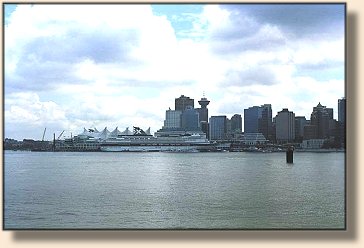
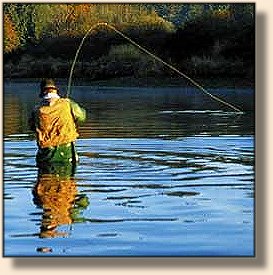
One might think that with all this asphalt and self-indulgent sprawl that fly fishing
opportunities would be scarce. But this is not so. The warm, wet climate and the
hundreds of miles of protected coast and the brown serpent of the Fraser River
are home to millions of fish. In a good year, for instance, 24,000,000 sockeye
salmon fin their way east to spawning channels. Every second year, as many as
15,000,000 pink salmon follow along behind them.
The other three salmon species are represented, too (chum, coho, and chinook),
along with sea run and fresh water cutthroat, rainbows, Dolly Varden, and
summer and winter steelhead. It is a 12-month of the year fly fishery.
URBAN CUTTHROAT
The downtown angler may rise from his five star hotel and stroll down West
Georgia St. to Stanley Park and, with sharp eyes, still find a searun cutthroat
trout or two on an English Bay Beach where in the background freighters ride
the water like transient mountains of yellow light. And just a short drive across
the symbol of Vancouver - The Lion's Gate Bridge - places the fly fisher at
the more consistently productive Capilano River and its adjacent beach front.
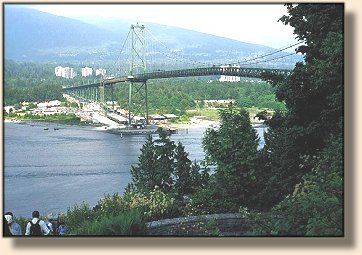
Searuns that find themselves in the city still like the same sort of habitat found
in more remote locations - beaches with plum-sized stones and an outlet
stream. On the north shore, this includes Cate's Park near Squamish and
the Little Campbell River on the lower mainland.
Searuns make for great sport year-round on 6 weights from a float tube
at the Little Campbell and at Crescent Beach on a low tide when the fish
stage before the estuary. Get out those gold (or yellow or red) Rolled
Muddlers along with a healthy supply of the standard Mickey Finns,
Glow bugs and Yellow Perils. Try the same gear and tactics at Mud
Bay, Pt. Roberts, and White Rock Beach.
The Semiahmoo Fish and Game Club can be thanked for the abundance
of fish, and cleaning up the previously urbanized Little Campbell. Thanks
to their efforts, fly fishers now have good opportunities for coho, springs
and a few summer steelhead in August and September.
SALMON RUNS AND BIG RIVERS
Vancouver is chiefly known for its big, broad rivers: the Fraser; Harrison;
Pitt and their many tributaries including the Alouette, Stave, Vedder,
Chehalis, and Squamish rivers.
The Fraser and its tributaries are the rivers that receive the big runs of salmon
from July to November - in some years extending into December. The first
salmon to nose their way into fresh water are the sockeye and the Harrison
river supports a growing fishery for these.
 From September to October is the time to hit the Harrison and Weaver
Creek for late-run sockeye with simple small flies (12 - 14) such as the
Dean River Lantern. All that is required is a fly constructed of chartreuse
and yellow marabou with some strands of crystal flash, flashabou or even
peacock herl thrown in for good measure. And if you are a recent convert
from steelhead gear fishing, you will be happy to know that the simplest
of all 'flies'-the yarn fly, that you can make on the river with a sliding
knot and some of that pink 'wool'-may prove just as effective as more
complicated offerings.
From September to October is the time to hit the Harrison and Weaver
Creek for late-run sockeye with simple small flies (12 - 14) such as the
Dean River Lantern. All that is required is a fly constructed of chartreuse
and yellow marabou with some strands of crystal flash, flashabou or even
peacock herl thrown in for good measure. And if you are a recent convert
from steelhead gear fishing, you will be happy to know that the simplest
of all 'flies'-the yarn fly, that you can make on the river with a sliding
knot and some of that pink 'wool'-may prove just as effective as more
complicated offerings.
Any local angler will tell you that sockeye have the reputation of being
decidedly closed-mouthed in freshwater. In the past, they were a source
of huge frustration, displaying themselves in their millions and completely
ignoring the offerings of anglers. But in the 1980s, Alaska, Vancouver
Island and Lower Mainland fly fishers keyed in on the secret of unlocking
their jaws - locate the fish in shallow stacking waters.
This is a swung fly fishery where the stacked fish may pluck a fly that floats
up to their noses, or alternatively hit when the fly has reached the end of its
swing. Sockeye will not move more than a few inches, so accuracy in the
drift makes the difference between double digit days and a big fat zero.
Note well that few fish are taken during stripping, and thus, as fish hold
a station, the only indication of a strike may be an imperceptible slowing
of the line. Strike up hard and keep those leaders to a maximum of 6'.
During October the first coho come back to the big rivers. After stopping
for a strategy session and fly purchase at a knowledgeable fly shop, trundle
down to the river they recommend with your fly box now stuffed with large
flies in the 2 - 2/0 range. Coho prefer red, orange, black and purple in
single colours or combinations. Black and purple leeches with collars are
popular. And don't forget the venerable but gaudy Popsicle that looks
more like the hat fluff from a Disneyland staffer climbing a fibreglass
Matterhorn than an actual working fly.
After the coho, the chum arrive in November. The Stave River in its
rehabilitated kilometre below the Hayward Lake dam offers stacking
fish that a first-time visitor will find hard to believe - and resist. Take
the short walk across the new park and fire bright silver, tinsel flash
and chartreuse flies to provoke strikes from the aggressive males.
You will be surprised at the size of the mating teeth supported by
these monsters, so take care when removing the fly prior to the release.
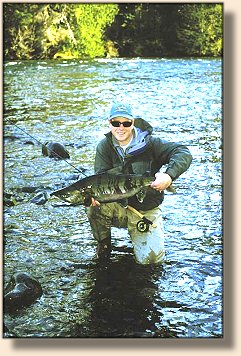
One thing to remember about chum is to fish where they are jumping.
Those few on the surface are a mere teaser to the hundreds beneath them.
Sometimes the water will look black from number of fish bunched together.
Tackle the highly-oxygenated slicks bordering currents. In this case, the
secret is to get the fly down to the fish. To do this, use weighted flies,
high-density sink tips and upstream casts followed immediately by
upstream mends.
Set the hook at any bump and then hold on. A ten-pound chum (and
they go as high as 25) in good shape will out-fight any other salmon
species in the river. So plan your fight before it happens, as you will
likely have to head off downstream in hot pursuit. Leaders should
be a minimum 12 pounds test.

The Vedder River may be a crowded place to fish, but there is reason
for this: 80,000 - 100,000 white spring salmon return in the fall. For
the fly fisher who has never had a 30 pound salmon on the line, this
one is for you. The magnificent strength of these fish as they deliberately
move upriver and down at will must be experienced to be believed.
When they take to the air you will find yourself stopped in shock for
a split second at their sheer size. But recover quickly, for this is the
time when leaders (12 -18 pounds) can separate like spider silk.
The trick to landing chinook salmon is to try and steer them into calmer
water by leaning your rod (8 weight minimum) to the downstream side
for pressure. This can be difficult with a fish that has already taken out
your flyline and is making fast work on your backing (30-pound braid),
but move in pursuit and thank your foresight if you have purchased
a large-arbour reel. ~ D.C. Reid
Concluded next time!
|




 Today, metro Vancouver has a population of over 2,000,000, stretching out
along the fertile Fraser River lowlands the better part of 40 miles and just short
of Hope at the western edge of the Rocky Mountains. Twenty percent of the
population is of Asian origin and the focus of the city is on the Pacific Rim
and high tech wizardry - such as the Ballard fuel cell.
Today, metro Vancouver has a population of over 2,000,000, stretching out
along the fertile Fraser River lowlands the better part of 40 miles and just short
of Hope at the western edge of the Rocky Mountains. Twenty percent of the
population is of Asian origin and the focus of the city is on the Pacific Rim
and high tech wizardry - such as the Ballard fuel cell. 
 From September to October is the time to hit the Harrison and Weaver
Creek for late-run sockeye with simple small flies (12 - 14) such as the
Dean River Lantern. All that is required is a fly constructed of chartreuse
and yellow marabou with some strands of crystal flash, flashabou or even
peacock herl thrown in for good measure. And if you are a recent convert
from steelhead gear fishing, you will be happy to know that the simplest
of all 'flies'-the yarn fly, that you can make on the river with a sliding
knot and some of that pink 'wool'-may prove just as effective as more
complicated offerings.
From September to October is the time to hit the Harrison and Weaver
Creek for late-run sockeye with simple small flies (12 - 14) such as the
Dean River Lantern. All that is required is a fly constructed of chartreuse
and yellow marabou with some strands of crystal flash, flashabou or even
peacock herl thrown in for good measure. And if you are a recent convert
from steelhead gear fishing, you will be happy to know that the simplest
of all 'flies'-the yarn fly, that you can make on the river with a sliding
knot and some of that pink 'wool'-may prove just as effective as more
complicated offerings.
